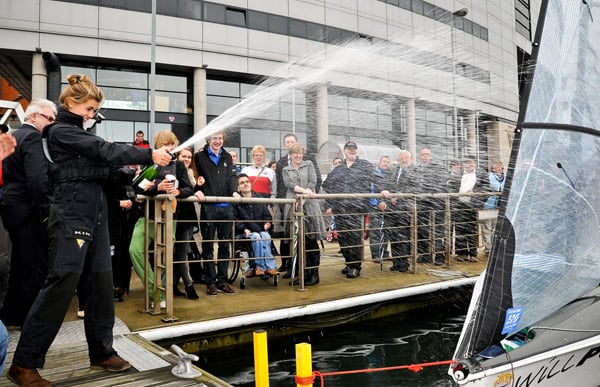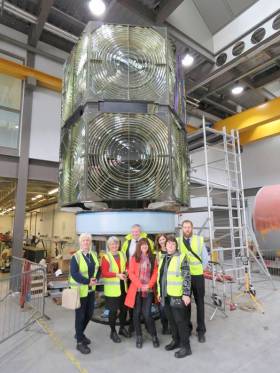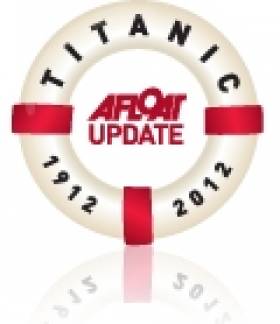Displaying items by tag: Titanic Quarter
Portaferry’s Exploris Aquarium Faces Uncertain Future As Belfast Competitor Gets Go-Ahead
Portaferry’s Exploris aquarium may soon face competition from a £12 million competitor in Belfast’s Titanic Quarter — and a battle for its own future, as the News Letter reports.
Belfast City councillors on the planning committee gave their approval for the ‘reefLife’ project on Wednesday — despite Ards and North Down Council raising their objections with Stormont’s Infrastructure Minister.
Exploris has faced financial challenges for years, and received an emergency lifeline from the Executive after it was earmarked for closure in 2013.
Now it’s feared the new Belfast aquarium plans would have “wider ramifications” for the Co Down seaside town, and have a “a devastating impact” on Exploris and its marine wildlife sanctuary on the Ards Peninsula.
The News Letter has more on the story HERE.
Mexican tall ship Cuauhtémoc is the star attraction at the Belfast Titanic Maritime Festival which continues till tomorrow, Monday 27 May.
The sail training ship is among the host of vessels — including Naval Service OPV LÉ Samuel Beckett — docked in the city’s harbour this weekend.
Belfast Live has all you need to know for how to get there and what to do among the wide array of activities, which this year spread across the Lagan from Queen’s Quay and the Titanic Quarter to Donegall Quay and the historic Sailortown district.
That maritime history is also the subject of a new exhibition charting a pioneering ID card system introduced for merchant seamen during the First World War.
Some 60 Sailortown locals have been identified among the cards that were discovered by David Snook while researching his own grandfather’s history, as BBC News reports.
The exhibition is currently on display at St Joseph's Church on Prince’s Dock Street.
#MewIslandOptic - The Titanic Foundation has secured funding to restore the famous Mew Island Optic for installation at Belfast’s Titanic Quarter.
Plans have been in motion of more than a year to display the rare lighthouse lens on the city’s waterfront, as previously reported on Afloat.ie.
But now those plans will soon see the light as ‘The Great Light’ with a funding award of £332,000 from the UK’s National Lottery.
The world’s first and largest hyper-radial Fresnel lighthouse lens was first installed in Tory Island Lighthouse in 1887 then reconfigured and moved to Mew Island in 1928.
The optic was removed from Mew Island Lighthouse in 2014 as the lighthouse was modernised and converted to solar power.
At around 130 years old, weighing 10 tonnes and standing seven meters tall, the Mew Island Optic is a unique heritage object of national and international importance with links to Northern Ireland’s maritime and industrial past.
Its massive beam could once be seen by mariners over 30 miles away as it guided them to and from the busy Belfast Lough.
The new project from the Titanic Foundation, in partnership with the Commissioners of Irish Lights, will see the optic given a new role as an iconic attraction which brings to life the story of lighthouses, their technological developments, their light-keepers and their role in the maritime and industrial history of Belfast and beyond.
The rotating optic will be displayed in a landmark curved glass structure in its new location on the Titanic Walkway, which is currently being developed by Titanic Quarter Limited and funded by Tourism Northern Ireland.
The 500 metres of maritime walkway will connect the Titanic and Olympic Slipways and the Alexandra Dock, linking Titanic Belfast, HMS Caroline and the Thompson Dock.
Alongside Heritage Lottery funding, the Titanic Foundation has secured £85,000 from Belfast City Council’s Local Investment Fund and £30,000 Ulster Garden Villages towards the project.
Yvonne Shields, chief executive of the Commissioners of Irish Lights, said she and her colleagues are “delighted to see our Mew Island Lighthouse Optic become part of Belfast’s world-famous Titanic Quarter.
“As ‘The Great Light’, the optic will tell the story of safety at sea, and educate generations to come on the science, engineering, and human effort that goes towards delivering this goal. In addition this will be a fabulous addition to our Great Lighthouses of Ireland tourism initiative that enables visitors to visit and stay in selected lighthouses around Ireland north and south.
“It is fitting that this unique optic comes to rest at the end of an interesting journey in Belfast, the proud maritime and industrial city it has announced to seafarers for so long. We wish the Great Light and the Titanic Foundation every success with this exciting new attraction.”
In July 2016, Belfast architects Hall McKnight were named the winners of a competition to design a structure to house the lighthouse optic.
With the recent appointment of contractors Hugh J O’Boyle Ltd, it is hoped that the optic will be in position later this year.
S.S. Nomadic Taken Over by Titanic Belfast
#TitanicsTender - The tender, SS Nomadic built alongside Titanic at Harland and Wolff shipyards, carried first and second-class passengers from Cherbourg onto the liner as she embarked on its maiden voyage.
According to Belfast Live, the SS Nomadic is being taken over by Titanic Belfast more than a century after it ferried passengers to the ill-fated liner.
The historic vessel, often referred to as 'Titanic's little sister', is the last remaining White Star ship. It is also the biggest artefact in the world with links to the famous liner.
The tender, built alongside Titanic at Harland and Wolff shipyards, carried first and second-class passengers from Cherbourg onto the liner as she embarked on its maiden voyage.
Built in 1911, it has enjoyed a colourful history. It served in both world wars and has also been used as a floating restaurant, a nightclub and a casino.
To read more on the tender's story, click here.
Titanic Quarter Developer Makes a Loss
#TITANIC - Titanic Island, the company at the head of the consortium developing Belfast's Titanic Quarter, made a pre-tax loss of £20 million (€25 million) in 2011, as BBC News reports.
Much of this has been attributed to a one-off payment of £13 million (€16.25 million) to the charitable trust that owns the new Titanic Belfast visitor centre on the shores of Belfast Lough.
The company's directors described the opening of the tourism hot-spot as the "tipping point" for the development and that "the pieces are in place" for the Titanic Quarter to become one of Ireland's most important commercial hubs.
Meanwhile, Titanic Island is in discussions with Ulster Bank about restructuring its loan support, which the firm's auditors say is essential if the development is to continue.
BBC News has more on the story HERE.
Easter Cruisecall to Belfast in Memory of Titanic
#TITANIC – The cruiseship Balmoral not only is the first caller to Belfast for 2012 as previously reported, but her arrival this morning marked more importantly as a cruise in the memory of the R.M.S. Titanic, writes Jehan Ashmore.
Cruise passengers embarked on the Fred. Olsen Cruise Lines ship last Tuesday in Southampton for a mini-cruise which included a call to Liverpool yesterday.
Today passengers where to visit the builders of the White Star Line liner launched a century ago at Harland & Wolff shipyard at Queens Island on the banks of the Lagan.
Adjoining the complex is the Titanic Quarter where the recently opened Titanic Belfast Visitor Experience is making an impression through the iconic landmark, for further details click HERE.
Trade, Tonnage and Turnover Up in Belfast Harbour
The principle driver in the ports performance came from the agri-food sector with a record 2m tonnes of grain and animal feed imports. The sector also recorded fertiliser imports alone leap by 32%, reflecting the major investment by the harbour in recent years in the dry-bulk cargo trade.
Roll-on roll-off (Ro-Ro) accounted for a 2% rise to 313,000 vehicles carried, partly due to the introduction of newer larger tonnage on the Belfast-Heysham route.
Belfast Harbour Chairman, Len O'Hagan, said: "Although trading conditions in the UK and Ireland remain weak, the increase in tonnages handled by Belfast Harbour suggests that business confidence is starting to return, albeit slowly.
"Belfast Harbour continues to operate in a highly competitive port sector, but I am pleased to note that the £160m which the Harbour invested in new facilities during the past decade has enabled it to emerge from the downturn with new customers and a presence in new sectors such as renewable energy.
Capital investment in the port worth almost £6m were undertaken during 2010, including the purchase of a new mobile crane, a 10,000 sq ft expansion in logistics space and preliminary works to support the proposed development of an offshore wind turbine terminal for DONG Energy (click HERE). The combined capital expenditure in these projects is in excess of £60m.
Within the ports real estate, projects at the Titanic Quarter progress at the Public Record Office, Belfast Metropolitan College and the core attraction of the 'Titanic Belfast' visitor centre.
Master planning for the 24-acre mixed-use City Quays site adjacent to the Harbour Office was secured. In addition planning permission was lodged for a 230,000 sq ft of space at Sydenham Business Park on the south-eastern fringes of the harbour.
Further upstream closer to the city-centre at the Abercorn Basin, initial work had been completed on a marina where there are more plans for the development of a 250-berth full-service leisure facility.
Next Monday the port's cruise business is to welcome a new cruiseship, the 66,000 tonnes Marina of Oceania Cruises. The 1,250-passenger /800 crew newbuild's arrival to Belfast comes in a year that marks the thirteenth anniversary since the first liner docked in the city. In 2011 over 30 such vessels are due to visit bringing some 50,000 passengers and crew.
- RORO
- Marina
- Port of Belfast
- Titanic
- Belfast Lough
- Belfast Harbour
- Titanic Quarter
- Len O'Hagan
- Belfast Harbour Commissioners
- Cruiseships
- Ports and Shipping News
- Dong Energy
- BelfastHeysham
- Belfast Lough News
- Drybulk
- Abercorn Basin
- Belfast Harbour Chairman Len O'Hagan
- Titanic Belfast
- Marina Oceania Cruises
- Offshore Wind Turbines
- Belfast Metropolitan College
- Sydenham Buinsess Park
- Belfast Harbour real estate
‘Bounty’ Joins Belfast’s Titanic Maritime Festival
The US-flagged replica tallship H.M.S. Bounty arrived into Belfast Lough this morning for the Belfast Titanic Maritime Festival (24-26 June), writes Jehan Ashmore.
Measuring some 200 tonnes, the three masted-replica ship of the original H.M.A.V Bounty where the famous mutiny against Captain William Bligh took place in Tahiti in 1789, is to open to the public.
The replica was constructed in Nova Scotia of the original Hull-built vessel for the 1962 MGM film 'Mutiny on the Bounty' starring Hollywood screen legend Marlon Brando.
The Bounty was also used in the filming of Pirates of the Caribbean II and a Lone Wolf Production Group documentary on Blackbeard and has featured in several documentaries.
'Bounty' will be open to visitors (for information www.tallshipbounty.org) and is to be accompanied by the Jubilee Sailing Trust's Lord Nelson (www.jst.org.uk/).
The festival venue is at the Queen's Quay, Abercorn Basin and Arc, behind the Premier Inn Hotel at the Titanic Quarter.
As for the Titanic, tours of the old main offices of the H&W shipyard on the Queen's Road courtesy of the Titanic Quarter Ltd will be open to the public with displays relating to Titanic and Edwardian Fashion.
In addition Titanic Bus Tours lasting two hours which are free are available from the Belfast Welcome Centre, to contact Tel: 028 9024 6609.
For a complete listing of the festival events, dates and opening hours go to www.belfastcity.gov.uk/maritimefestival/index.asp
- Belfast
- Port of Belfast
- Lord Nelson
- Belfast Lough
- Titanic
- Jubilee Sailing Trust
- Titanic Quarter
- Belfast Harbour Commissioners
- Tahiti
- Harland & Wolff
- Belfast Lough News
- MGM
- Hollywood
- Maritime Festivals
- Mutiny on the Bounty
- Captain William Bligh
- Marlon Brando
- H.M.S. Bounty
- H.M.A.V. Bounty
- The Bounty
- MGM Film Studies
- Replica tallship
- Maritime Events
- SS Titanic
- H&W
- JST
- Holiday Inn
- Queen's Quay
- Abercorn Basin
- Titanic Quarter Ltd
- Belfast Welcome Centre
Belfast Olympic Hope Presents £18,000 Boat to Charity
Twenty-year old sailor Tiffany Brien from Royal North of Ireland Yacht Club presented an £18,000 Paralympic sailing boat to local disabled charity Belfast Lough Sailability in Belfast Harbour today – the culmination of two years of fundraising by the 2012 Olympic hopeful.
The boat was officially launched today at Abercorn Basin, Titanic Quarter Belfast and was formally named 'Will Power' by Tiffany and Len O'Hagan, Chairman of Belfast Harbour. The significance of the name relates to a very close friend of Tiffany's, Will Doggart, who was paralysed last year following an accident. Will attended the launch today and has sailed in the new boat alongside Tiffany.
The 'Skud 18' sailing boat took two years to build in Australia and is the most high tech paralympic boat available. 'Will Power' is the first of its kind to arrive in Ireland and has already been committed to the goal of qualifying for the Irish Paralympic sailing team for the 2012 Paralympic Games - with local athlete Steve Frecknell hoping to compete for a medal. The boat will be the responsibility of Carrick based sailing charity Belfast Lough Sailability who will also use the boat to help disabled sailors to sail competitively in Northern Ireland.
Tiffany Brien began her fundraising campaign two years ago when she sailed 30 miles single-handedly across the Irish Sea from Portpatrick in Scotland to Belfast Lough raising a total of £18,400. Before launching the boat today she commented: "I am so excited to be sailing the new boat in Belfast Harbour today. It feels like I have been waiting for a long time for it to arrive. It is even more exciting that the Irish Paralympic sailing team has committed to using the new boat in their campaign for the 2012 Paralympic Games - fingers crossed it helps to bring a medal back."

Tiffany will also be hoping to bring an Olympic medal back to Northern Ireland as she is currently competing to represent Ireland in the Laser Radial Class at the 2012 Olympic Games.
Nigel Thompson, Chairman of Belfast Lough Sailability comments: "Everyone at Sailability is totally overcome with the sheer determination and generosity Tiffany has shown in her fundraising campaign. The arrival of the boat today is the culmination of the dedication and resolve demonstrated by this young lady when she sailed singled handedly across the Irish Sea. Not only will our Paralympic hopefuls benefit from this but many other disabled sailors in Northern Ireland will get to enjoy this exceptional boat - including Tiffany's friend Will, who hopes to become an active member of Sailability and a keen sailor. We would like to thank Tiffany sincerely and wish her the best of luck in her own Olympic campaign."
Belfast Lough Sailability is a "not for profit", volunteer-based charity which, through the activity of sailing, enriches the lives of people with any type of disability, the elderly, the financially and socially disadvantaged.
Belfast Harbour has been the principal sponsor of Tiffany's Sailability campaign. BTWCairns, Airtricity, Stena Line, Belfast Telegraph and Ulster Bank and Brook House Art & Design are associate sponsors.





































































